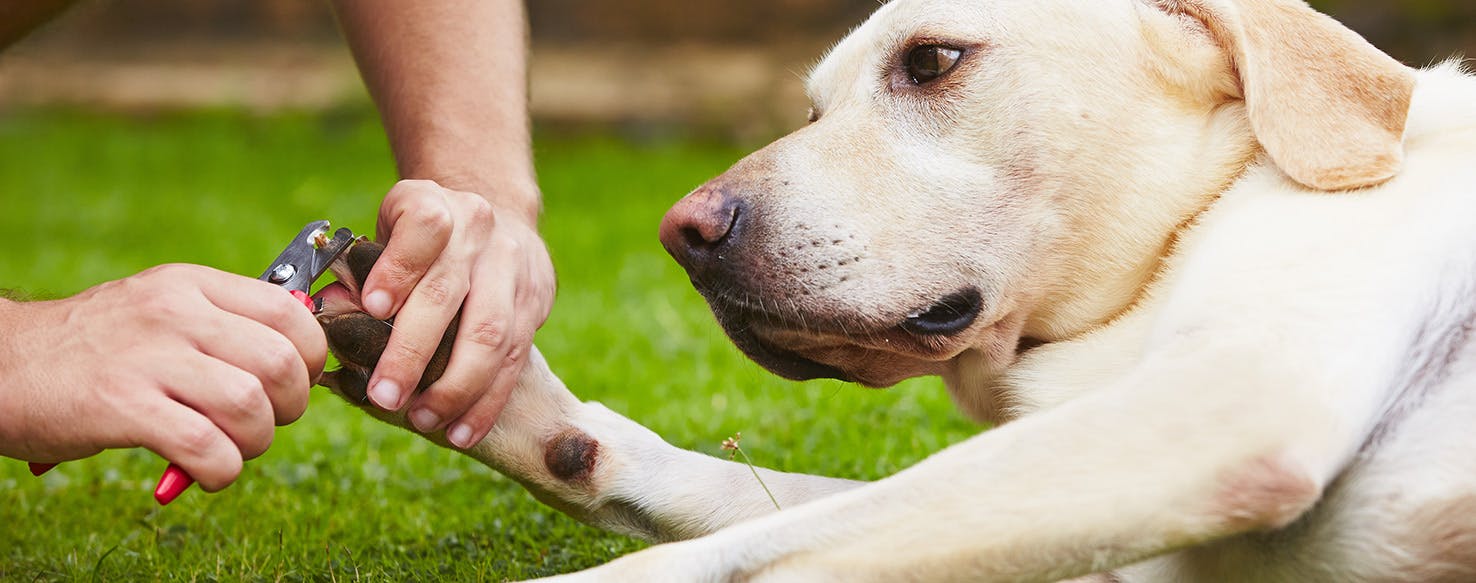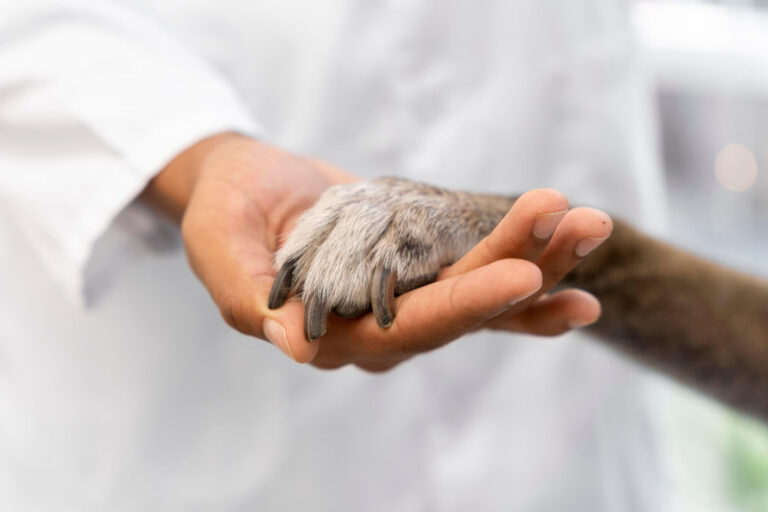To stop a dog’s nail from bleeding, apply styptic powder or a homemade paste of baking soda and water to the nail. Gently apply pressure for a few minutes to allow the bleeding to stop.
When your dog’s nail starts bleeding, it can be a concerning situation. However, with the right knowledge and tools, you can stop the bleeding and ensure your pet’s comfort. We will discuss the causes of nail bleeding in dogs, the steps to stop the bleeding, and some tips to prevent it from happening in the future.
By the end, you’ll be equipped with the necessary information to handle this situation confidently and effectively, ensuring your dog’s wellbeing.
Understanding Nail Structure
When a dog’s nail is cut too short, it can lead to bleeding. Understanding the anatomy of a dog’s nail is crucial to preventing this occurrence. The nail consists of layers, with the quick being the innermost part that contains blood vessels and nerves. To avoid cutting the quick, identify it by looking for the pink portion within the nail. Take caution to avoid cutting this area when trimming the nails. In the event of bleeding, apply styptic powder or cornstarch to the affected area to help stop the bleeding. Additionally, applying gentle pressure and keeping the dog calm can aid in the process of clotting. By carefully attending to the nail’s structure and quick, it is possible to prevent and address bleeding effectively.
Preparing For Emergencies
Ensure your first-aid kit contains styptic powder or silver nitrate sticks for dressing minor nail injuries. Create a calm environment for your dog by remaining composed during emergencies. Practice deep breathing exercises to maintain a steady disposition during nail injuries. Use positive reinforcement training to desensitize your dog to nail trimming and handling. Offer treat rewards for cooperative behavior, building a positive association with nail care. Establish a reliable routine for regular nail maintenance, reducing the risk of future injuries. Incorporate nail grinding into your grooming routine, reducing the likelihood of nail trauma. Seek professional veterinary care if bleeding persists or if you are uncertain about the severity of the injury.
Assessing The Bleeding
When recognizing severity of a dog’s nail bleeding, it is crucial to remain calm and focused. Examine the nail to determine the level of bleeding – is it a slow oozing or a rapid flow? Apply gentle pressure with a sterile gauze pad to help stop the bleeding. In cases of minor bleeding, a pinch of cornstarch or a styptic pencil can be applied to the nail. However, if the bleeding is excessive and doesn’t stop, it’s imperative to seek veterinary assistance immediately.
Your dog’s well-being is paramount during this stressful situation. Maintain a soothing tone and demeanor to reassure your pet. Offer treats and comfort to alleviate any anxiety or stress they may be experiencing. A calm environment can greatly assist in supporting the healing process.
Direct Pressure Technique
To stop a dog’s nail from bleeding, use the direct pressure technique by following these step-by-step instructions:
- Apply clean gauze or cloth to the bleeding nail.
- Apply firm and constant pressure to the area for several minutes.
- If the bleeding persists, consider using a styptic powder or pencil.
How To Apply Styptic Remedies
When applying styptic remedies to stop a dog’s nail from bleeding, it’s important to act quickly and remain calm. Start by cleaning the affected area with a gentle antiseptic solution to prevent infection. Next, apply the styptic powder or gel directly to the nail, avoiding excessive pressure. If using styptic powder, dip the nail directly into the powder, ensuring full coverage. For styptic gel, apply a small amount directly to the bleeding nail. Hold gentle pressure on the affected area for a few minutes to allow the remedy to take effect. Additionally, it’s crucial to monitor the nail for any signs of continued bleeding and apply further remedy if necessary. Always seek professional veterinary care if the bleeding persists or if you’re unsure about the proper application techniques.
When it comes to precautions and tips, it’s important to keep styptic remedies on hand in case of emergencies. Ensure that the products are specifically formulated for pets to avoid any adverse reactions. Moreover, remain patient during the application process to minimize any discomfort for the dog. With these proper application methods and precautions in mind, you can effectively address a dog’s nail bleeding and provide appropriate care for your pet.

Credit: wagwalking.com
Cornstarch And Baking Soda
To use kitchen items like cornstarch or baking soda to stop your dog’s nail from bleeding, start by applying a small amount of cornstarch or baking soda to the bleeding nail. Gently press the powder onto the nail with a clean cloth and hold it in place for a few minutes. The powder helps to clot the blood and stop the bleeding. Reapply the powder if bleeding continues, and be sure to monitor your dog to ensure the bleeding has stopped.
Soap Bar Trick
When your dog’s nail is bleeding, one effective trick is to use a bar of soap to help seal the wound. Begin by pressing the injured nail into a bar of soap; the substances in the soap will aid in stopping the bleeding. This is an easy and accessible method that can be done at home. The soap helps to form a protective barrier over the wound, which prevents further bleeding and promotes the healing process. Keep in mind that while this trick can be helpful, it’s important to monitor your dog’s nail and seek veterinary attention if the bleeding persists or if there are any signs of infection.
Ice Therapy Advantages
Ice therapy can help in reducing blood flow gently when it comes to a dog’s nail bleeding. Applying ice to the affected area can constrict the blood vessels and slow down the bleeding process. This method can provide quick relief and help in stopping the bleeding. After trimming a dog’s nails, if you accidentally cut too deep and the nail starts to bleed, using ice therapy can be an effective first-aid technique to manage the situation.
Bandaging For Protection
It is crucial to remain calm when dealing with a dog’s nail that is bleeding. Start by applying gentle pressure to the nail using a clean cloth or gauze to stop the bleeding. If the bleeding doesn’t stop, you can use a styptic powder or a styptic pencil to aid in clotting. Ensure that the paw is clean and dry before applying the powder. To protect the injured nail, you can bandage the paw using adhesive tape and a gauze pad. It’s important to monitor the bandage and ensure that it is not too tight or restricting blood flow. Proper bandaging techniques will help in the healing process without causing any discomfort to the dog.
Monitoring And Infection Prevention
After stopping a dog’s nail from bleeding, it’s crucial to monitor the nail for any signs of infection. Observe the nail for redness, swelling, warmth, or discharge, as these can indicate an infection. If any of these symptoms are present, it’s important to pay attention to the dog’s behavior as well. If your dog becomes lethargic, stops eating, or shows signs of discomfort, these could be indicators of an infection. In these cases, it’s essential to seek veterinary care promptly.
Gradual Desensitization Techniques
When it comes to gradually desensitizing your dog to nail trimming, the key is to start slow and be patient. Begin by gently handling your dog’s paws and rewarding them with treats. Gradually introduce the sensation of the nail clippers or grinder, allowing your pet to become familiar with the sound and feel. It’s important to maintain a calm and reassuring demeanor throughout the process, as positive reinforcement is crucial for success. Additionally, be sure to provide plenty of praise and encouragement as your pet becomes more comfortable with the process. Remember, gentle, gradual exposure is the key to helping your dog overcome their fear and stop their nails from bleeding.
Rewards And Positive Reinforcement
When your dog’s nail is bleeding, it’s important to remain calm and provide immediate care. Start by gently applying pressure to the nail with gauze or a clean cloth to stop the bleeding. You can also use styptic powder or a pencil to help coagulate the blood.
Once the bleeding has stopped, it’s crucial to reward your dog for staying calm and cooperative during the process. Use positive reinforcement such as treats, praise, and affection to encourage good behavior. This will help build trust and make future nail care more manageable.
Consistent training and positive experiences will help your dog feel more comfortable with nail care. Remember to remain patient and gentle, and always seek veterinary assistance if the bleeding is severe or doesn’t stop.
When To Seek Professional Help
In most cases, home care for a dog’s bleeding nail can be managed effectively. Applying pressure and styptic powder are common methods to stop the bleeding. If the bleeding persists or is excessive, it is important to seek professional care. Professional help is also necessary if the bleeding is caused by a torn nail or if the dog is in pain. Differentiating between home care and professional care is crucial. Professional care involves more complex treatments such as cauterization or suturing. In addition, veterinarians can assess the extent of the injury and provide the necessary medications to prevent infection and promote healing. Remember, the well-being of your dog is the top priority, so seeking professional help when needed is essential.
Regular Nail Trimming Benefits
Regular nail trimming for your dog is essential for maintaining their overall health and well-being. Keeping your dog’s nails at an appropriate length can prevent future injuries and discomfort. By regularly trimming your dog’s nails, you can ensure that they do not have overgrown nails that may cause them to slip and injure themselves. Proper nail care can also help your dog maintain proper posture and foot alignment, reducing the risk of joint pain and other musculoskeletal issues. Additionally, regular nail trimming can also help to prevent ingrown nails, which can be incredibly painful for your furry friend. By making nail trimming a part of your dog’s regular grooming routine, you can help ensure their long-term comfort and mobility.
Frequently Asked Questions For How To Get A Dog’s Nail To Stop Bleeding
How Can I Stop My Dog’s Nail From Bleeding At Home?
To stop your dog’s nail from bleeding at home, apply styptic powder or cornstarch to the nail tip to stop the bleeding. Avoid using human products and gently apply pressure to the nail until bleeding stops.
What Are Common Causes Of A Dog’s Nail Bleeding?
Common causes of a dog’s nail bleeding include overgrown nails, accidental snags, or tearing when playing. It can also occur due to underlying health issues. Regular nail trimming and avoiding excessive activity can help prevent bleeding.
When Should I Seek Veterinary Care For My Dog’s Bleeding Nail?
Seek veterinary care if the bleeding doesn’t stop within 10-15 minutes or if the bleeding is excessive. Professional examination and treatment may be needed if the bleeding is caused by a deep cut or underlying nail issues.
Can I Prevent My Dog’s Nails From Bleeding In The Future?
Prevent your dog’s nails from bleeding by maintaining a regular nail trimming schedule. Use proper nail clippers for dogs, avoiding the quick, and rewarding your dog for staying calm during nail trimming sessions. Regular walks on rough surfaces can also naturally grind down nails and reduce the risk of bleeding.
Conclusion
In closing, understanding how to stop a dog’s nail from bleeding is essential for pet owners. By following the proper techniques and remaining calm, you can effectively address this common issue. It’s important to seek veterinary advice if necessary to ensure your dog’s health and safety.
With the right knowledge and care, you can confidently help your pet through this situation.



